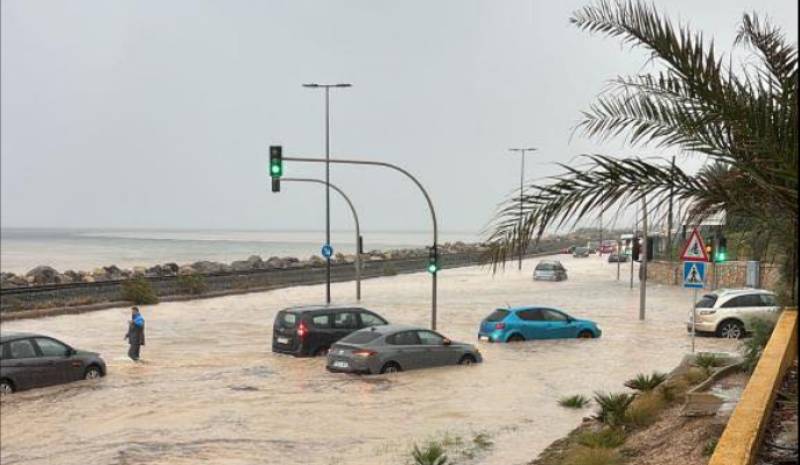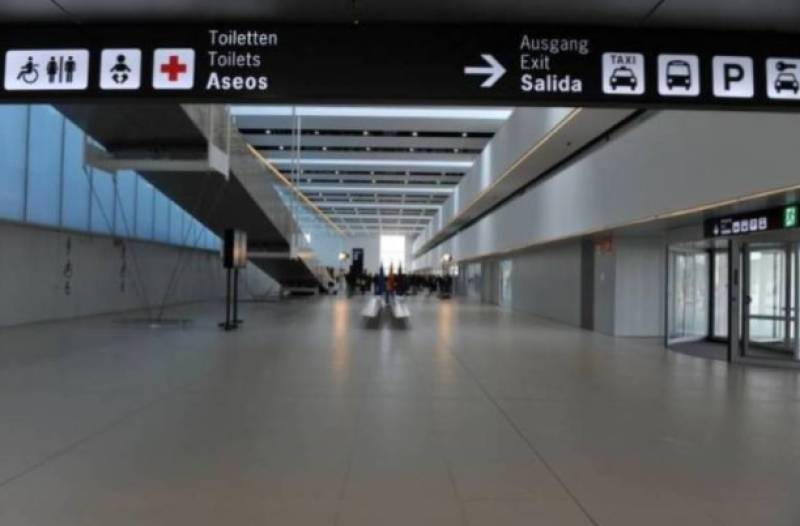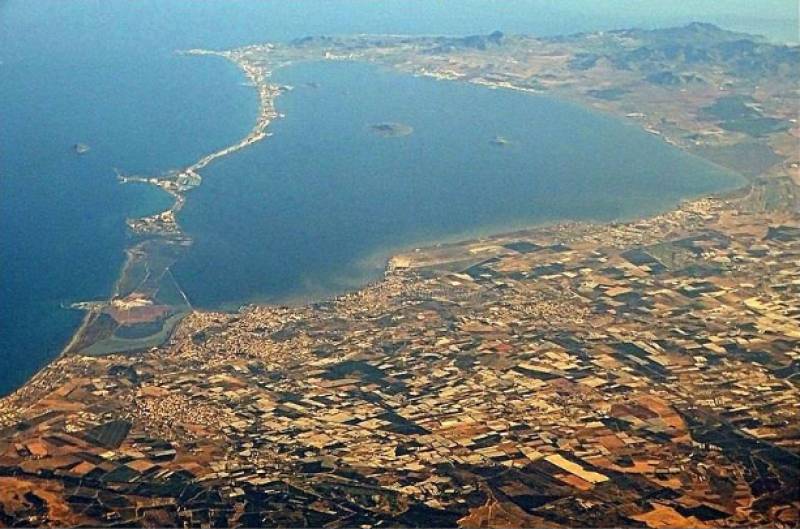Spanish News Today Editors Roundup Weekly Bulletin Oct 10

TOP STORIES: "Red alerts for torrential rain issued across southern Spain" & "Monday October 13 is a bank holiday, but only in these 5 regions of Spain"
This week definitely started out with a more autumnal feel, but now? Well, the rain has turned positively biblical! Those of us living in Murcia or Alicante have to really batten down the hatches as there’s a red weather warning in place this Friday, but there’s already been a deluge in most parts with plenty more rain to come over the weekend.
To try and brighten spirits a bit, we’ve got plenty of juicy news from the last few days. So grab a cuppa (and maybe a hot water bottle) and we’ll dive right in.
Weekend washout
I guess we have to start with that weather right?
So, DANA Alice has well and truly arrived, and she's brought an absolute deluge with her. If you're in Murcia or Alicante, you'll already know that Friday October 10 is shaping up to be a proper washout, with Aemet slapping
a red warning across the southern coast and describing it as a "high-risk episode." Flash flooding is a very real possibility, so this isn't one to take lightly.
That's the kind of downpour that turns streets into rivers in minutes.
Unsurprisingly,
schools and social centres across Campo de Cartagena and Mazarrón have been closed for the day. If you're in San Javier, San Pedro del Pinatar, La Unión, Los Alcázares, Torre Pacheco, Fuente Álamo, Mazarrón, or the Murcian districts of Lobosillo, Sucina, Gea y Truyols, Avileses or La Tercia, the kids are staying home.
Elsewhere in the Region, the Vega del Segura is on orange alert, while the Guadalentín Valley, Lorca and Águilas are on yellow. Even Thursday wasn't exactly pleasant, with orange and yellow warnings plastered across nearly the entire Region and rainfall of up to 15 litres per square metre experienced almost everywhere.
Our neighbours in Valencia have already felt DANA Alice's wrath.
An orange alert forced the postponement or cancellation of events planned for Thursday (which, rather unfortunately, happened to be Valencian Community Day). L'Albufera de Valencia clocked 50 litres per square metre, while Catarroja, still recovering from last year's devastating floods, recorded 40 litres. Massalavés and Alcàsser weren't far behind with 35.6 and 35.1 litres respectively.
Over in the Balearics, Ibiza and Formentera shut their schools on Thursday and up in Tarragona, the Civil Protection Agency put the Inuncat plan on pre-alert due to the risk of sudden flooding in ravines and rivers. Authorities are urging everyone to be cautious and avoid flood-prone areas.
Just a quick reminder: a red alert is the absolute top level of weather warning. It means there's serious danger to life and property, and you need to act immediately. If there's a red alert in your area, please follow official instructions, stay glued to news updates, seek shelter, avoid travelling unless absolutely necessary and keep well away from anywhere that might flood.
We've had our share of wild weather over the years, but DANA Alice looks like she means business. Stay safe, stay dry and maybe invest in some wellies!
Monday off?

The spell of bad weather couldn’t really have come at a worse time since this Sunday October 12 is Día de la Hispanidad, one of the most important dates on the holiday calendar in Spain.
It's also known as Spain's National Day (Fiesta Nacional de España) and commemorates Christopher Columbus's arrival in the Americas in 1492.
Just as a quick reminder, workers in Spain are entitled to 14 paid holidays per year: eight fixed national holidays which cannot be changed (like January 1, May 1 and December 25), four regional holidays and two local holidays.
When a national holiday like October 12 falls on a Sunday, it's up to each regional government to decide whether to move it to Monday or not.
As we said, this year, only five autonomous communities have decided to shift the holiday to Monday the 13th: Andalucía, Aragón, Asturias, Castilla y León and Extremadura.
The autonomous city of Melilla has also opted to move its non-working day to Monday. In these regions, workers will be able to enjoy a proper long weekend (Saturday the 11th, Sunday the 12th and Monday the 13th), perfect for a little getaway... weather permitting, of course!
Coastal crisis
Senator Francisco Bernabé of the Popular Party is fighting their corner. "They are legal buildings, with their public deeds, registered in the property registry, paying their taxes, and, of course, all fully established in their urban environments," he explained.
But here's the problem. The new coastal boundary line drawn by the Coastal Authority now puts these homes on public land, meaning many could be demolished unless the law changes.
The PP has had enough of the delays and is now taking the battle to Spain's highest court, the Constitutional Court, in an attempt to force Congress to sort out the legislation.
Bernabé is pulling no punches. "If this attitude of legal fraud does not desist, we will take personal legal action against the Speaker of the Congress of Deputies, Francina Armengol, and the rest of the Bureau members," he warned.
The bill has been held up more than 60 times and his patience has well and truly run out.
The families affected aren't going down without a fight either. Many are appealing the demolition orders, though the results so far haven't been encouraging. Two homes in Cabo de Palos have already lost their appeals, with their owners now heading to the Supreme Court as a last resort.
If the appeals fail, families won't just lose their homes. They'll also have to foot the bill for their own demolitions, without receiving a single cent in compensation.
This whole coastal law controversy has become an absolute nightmare for homeowners who feel the system is completely stacked against them. It raises serious questions about property rights and coastal management in Murcia, as well as how to balance environmental protection with the security and stability of local residents.
For now, hundreds of people are left in limbo, uncertain about the future of the houses, and the lives, they've worked so hard to build.
Covid comeback?
Just when you thought you'd heard the last of it, Covid's back in the headlines. Two new variants, called Nimbus and Stratus, are doing the rounds and catching experts' attention due to their increased transmissibility and symptoms that can easily be mistaken for a common cold or flu.
Professor Raúl Ortiz de Lejarazu is urging caution, particularly for vulnerable groups, reminding us that "this virus is still with us."
The main concern is for older people, especially those over 70, who are far more likely to experience severe cases. But Professor Ortiz is keen to stress that these new variants aren't any more dangerous than previous ones.
Symptom-wise, expect the usual suspects like cough, fever, sore throat and possibly some gastrointestinal issues like diarrhoea or nausea. The real danger is that with autumn bringing its usual wave of respiratory illnesses, these Covid variants can easily fly under the radar.
So while there's no need for alarm, the experts recommend staying vigilant, especially if you're in a vulnerable group, and keeping up with vaccination booster campaigns.
Murcia

One of the main stories occupying the front pages of the regional press in Murcia this week has been
the start of the trial in the Novo Carthago case, reviving memories of yet another large-scale development plan on the Costa Cálida that spectacularly failed in the early years of this century.
Following the success of the initial Polaris World developments, the Novo Carthago project aimed to create a mega resort close to the inland shore of the Mar Menor, near the ancient monastery of San Ginés de la Jara and Llano del Beal. Promoted by Hansa Urbana, the plan was to build more than 10,000 homes, luxury hotels, several golf courses and numerous leisure centres, a project that would have dwarfed other developments like La Torre Golf Resort and Mar Menor Golf Resort.
Like so many ambitious projects at the time, this one received enthusiastic backing from the regional government. Regional president Ramón Luis Valcárcel was present at the first presentation back in 2003. But serious doubts were raised from the start about the legality of building on agricultural and protected land close to Europe's largest saltwater lagoon. These doubts proved well-founded when the courts eventually established that building would not be permitted because the land alongside the salt marsh of Lo Poyo was classified as non-buildable and was included in the Red Natura 2000 list as an area of Community Importance and a Special Birdlife Protection Zone.
Despite these seemingly obvious barriers, the promoter and political authorities decided to simply change the rules governing land use. A review of the "Plan de Ordenación de Recursos Naturales" was signed off by leading figures in the regional government, and some of them are now on trial, accused of reclassifying land use for their own personal gain.
Also appearing is the former Mayoress of Cartagena, Pilar Barreiro, who resigned in 2015 after 20 years in office and was later found guilty of misuse of public funds before being absolved due to lack of evidence in 2018.
When the Novo Carthago project was abandoned, the cause was initially blamed on the property market collapse following the 2005-2008 bubble burst. But it has since been condemned by the European Commission, which even threatened to fine Spain for allowing such an idea to be put forward in the first place. Over the years, the case has become a symbol not only of financial corruption but also of how supposedly sacrosanct environmental principles can be sacrificed in the name of political and economic progress.
Now, former regional government ministers Antonio Cerdá and Joaquín Bascuñana are finally standing trial, accused of perversion of justice, bribery, influence trafficking and issuing false documents.
Defence arguments have included claims that the charges have taken so long to bring they're no longer relevant, and Pilar Barreiro's brief appearance consisted mainly of her repeated claim that she doesn't recall the events, despite them having resulted in this court case looming over her for most of the last two decades.
The whole mess dates back to July 2007, when Sacyr won the concession to build and operate the Region's shiny new airport at Corvera. The plan was to have it open by 2012. As we all know now, that didn't happen.
By 2013, the Ministry of Public Works had lost patience entirely and terminated the contract. The concessionaire, operating under the name Aeromur, filed for pre-bankruptcy proceedings to try and refinance roughly €200 million in debt.
The airport finally welcomed its first passengers in January 2019, a full 16 years after the project was declared of general interest to the State. By then, it was under Aena's management.

There is a bit of an unlikely twist to the story, though. The regional government will actually benefit from the payment itself, as it leads the creditors' list with more than 90% of the concession's debt. So while they've been ordered to pay out €160 million, most of it will flow straight back to them through the bankruptcy proceedings.
Despite this, the regional government announced on Tuesday October 7 that it will file an appeal. Their argument is that the ruling didn't take into account a new settlement balance issued in January showing €61 million in their favour. They reckon Sacyr actually owes them money for damages caused by the delays, not the other way round. This clearly isn't over yet.
The idea is simple: borrow a book while you wait and pass on something good when you're done. The initiative forms part of the airport's ongoing Quality Plan and was boosted by donations from local public libraries and airport staff.
The cut price tickets are valid for travel between December 14 this year and August 2, 2026, and the French company is also adding a new daily service, boosting capacity by 50% compared to 2025.
From mid December, Ouigo will run six trains daily between Madrid and the Region of Murcia, three in each direction.
The new morning service from Murcia del Carmen station leaves at 6.35am, while the new evening train from Madrid Chamartín departs at 6.45pm. All trains stop at Elche and Albacete, and four of the services also call at Alicante.
The journey takes around three hours and standard tickets from mid December start at €9. Children aged 4 to 13 travel for €7 and under 3s go free if they sit on an adult's lap.
They're inviting shoppers to step into the spotlight and become models for a day. A content creator will be encouraging anyone who tries on or buys a look to join their very own runway experience, creating stylish, aspirational reels with serious viral potential.
To sweeten the deal, they're launching a fashion voucher giveaway for everyone who takes part.
The new space in the El Tapiado Industrial Park spans more than 600 square metres and features more than 20 taps pouring beers from 10 different countries, including Belgium, Germany, Ireland, Japan and the United States. They'll also serve vermouth on tap, a selection of ciders and both local and international dishes.

The opening night begins this Friday at 8pm with special offers and discounts, and those arriving first will have the chance to win prizes through scratch off tickets.
On Saturday, the brewery opens at noon with a lively "Vermuteo" session featuring free paella tapas and live music from Los Duques, a local band covering Spanish rock classics from the 80s and 90s.
Sunday will see a craft, cultural and charity market hosted in collaboration with the Molina de Segura animal shelter, plus plenty of entertainment including table football, billiards and children's arcade games.
After the opening weekend, Cervemol will operate from Tuesday to Friday between 6pm and midnight, and from 12.30pm to midnight on Saturdays and Sundays.
Good beer, good music and good company sounds like the perfect weekend plan to us.
See our EVENTS DIARY for more events and activities coming up soon in the Region of Murcia:
Spain
The always-popular Imserso tourism scheme is back for another season. Created decades ago to make holidays affordable for pensioners while helping to fill hotels during the quieter months, it’s still going strong. Every autumn, tens of thousands of retirees pack their bags for a well-earned break in the sun, paying only a fraction of what most of us would.
These holidays typically last a week or two and include everything from transport and accommodation in three- or four-star hotels to full board, insurance and organised activities. The destinations are classic crowd-pleasers, from beach holidays on the Costa Blanca, Costa del Sol and the islands, to city breaks in Madrid, Valencia or Sevilla, and inland tours through charming towns and natural parks. There are even spa-focused getaways for those who fancy something a bit more restorative.
Prices stay low thanks to a government subsidy and this year, 7,447 spots are being offered at an even greater discount of €50 for those on lower incomes.
Bookings are opening in stages from October 6 and those eligible can reserve their trip either online through
turismosocial.es or
mundicolor.es, or by popping into a travel agency with their ID.
Gone are the days of passport stamps. Instead, non-EU visitors, including British travellers, will have their details recorded digitally with fingerprints and photos. It’s being introduced gradually between now and April 2026, so not every country will switch over immediately. The idea is to help manage the 90-day stay limit and strengthen border security.
If you live in Spain and hold residency, you don’t need to worry as the checks won’t apply to you. For everyone else, expect to spend a little more time at passport control the first time you travel under the new rules while you’re registered into the system. Kids under 12 only need a photo and travellers with e-passports will be able to use automated gates for a faster experience.
Once your details are in the system, things should move much quicker on future trips. Still, it’s best to allow extra time during the transition. The old stamp system will continue alongside EES for a few months in most places.
This doesn’t mean you’ll see cannabis in your local pharmacy, though. It will only be available through hospital specialists and in oil-based forms rather than flowers or buds.

Initially, it’s being prescribed for chronic pain, severe epilepsy and muscle spasms caused by multiple sclerosis. But the rules have been written with flexibility in mind, allowing new medical uses to be added as research evolves.
Meanwhile, the less welcome news for employees in Spain is that their payslips will soon feel a bit lighter. The Intergenerational Equity Mechanism, or MEI, has been quietly trimming take-home pay all year and
it’s set to rise again in 2026.
The MEI is essentially a pension fund contribution designed to keep the system afloat as baby boomers retire, but it means everyone paying into Social Security will see slightly less in their bank accounts.
From January, the contribution rate goes up to 0.90% of your gross salary. Most of that is covered by your employer, but the bit you pay personally will also increase.
For someone earning €1,500, it works out to about €2.25 a month, which doesn’t sound like much, but it adds up, and the rate will keep climbing each year until 2029. It’s a small but steady squeeze on workers’ pay at a time when every euro counts.

They’ve asked regulators to approve emergency changes that would give them more power to react quickly when supply levels dip, particularly as renewable sources like wind and solar can fluctuate. But these fixes come at a cost. Red Eléctrica has already warned that electricity bills are likely to rise as a result.
It’s a worrying U-turn from the operator’s earlier reassurances that renewables weren’t to blame for April’s outage. Government officials have now told Red Eléctrica to get its house in order and promised tighter oversight.
For now, Spain’s grid remains under strain and there’s a chance consumers might end up paying for the improvements.
Alicante

Ever had one of those days where you just want to smash everything in sight?
Well, soon you will be able to vent that frustration at Benidorm’s first ever Rage Room, which will offer an array of objects that you can smash to pieces until that red mist subsides and you feel serene again - without hurting yourself or anyone else.
Break&Joy has already opened rage rooms in several other Spanish cities so seems to have tapped into an appealing way of dealing with the frustrations of modern life.
Participants are kitted out in full protective gear, including gloves, goggles and a full-body suit, then given a choice of tools (bats, hammers) to wreak havoc with.
Objects available for destruction range from delicate glassware to small electrical appliances, all carefully chosen to be broken without risk, or even bring something of your own that may particularly want to destroy (subject to approval).
If you wish to let loose in a messier but less destructive way, Break&Joy also offers a Paint Splatter Room, where you can throw paint at canvases or walls to create your very own Jackson Pollock.
Or for the ultimate adrenaline rush, the “Destroy a Car” session enables you to spend two hours smashing a real vehicle.
And afterwards you can sit back and reflect on this cathartic experience in their special relaxation room.
Sadly, some people resort to violence against other people rather than inanimate objects, often with horrific consequences.
A 19-year-old British holidaymaker, Samantha Shaw from York, was left with serious injuries following a violent attack in Benidorm late on Sunday September 21.
According to Samantha, an incident that began with an argument over a spilled drink led to her and her partner being followed outside.
She said she was attacked from behind by a man who hit her in the head or neck, then stabbed her with a bottle, apparently smiling as he did so.
Samantha suffered deep cuts to her neck and arm, and passing tourists had to stem the bleeding until police and medics arrived.
Doctors have advised Samantha that she will not be able to drive or return to work for at least two months.
“I thought I was going to die. I can’t sleep, I have nightmares, and I don’t think I’ll ever go back.
Benidorm has changed a lot; it’s not what it used to be,” commented Samantha.
It's always interesting to see how changing times affect the names that parents choose for their babies.
Every country has certain classics which remain popular for generations, while others fall in and out of fashion, and some suddenly become popular thanks to influences from abroad or even from celebrities.
Whatever the reason, one name that has appeared for the first time in the top 20 chosen by parents in Alicante (and several other provinces) between 2020 and 2023 is not Spanish but Irish, and originally derives from German.
Liam is an abbreviated form of Uilliam, the Gaelic version of William, which is Guillermo in Spanish and derives from the Germanic Willhelm, which could be interpreted etymologically as meaning “determined protector” or “desire to protect”.
This diminutive version is short and easy to pronounce in Spanish, and there are numerous famous Liams who could have influenced this decision, including actors (Liam Neeson, Liam Hemsworth or Liam Garrigan), athletes (tennis player Liam Broady, cricketer Liam Plunkett or ex-footballer Liam Brady) and musicians (Liam Gallagher of Oasis, Liam Howlett of The Prodigy or Liam Payne of One Direction).
But whatever name we are given, Shakespeare’s immortal words still ring true: “That which we call a rose by any other name would smell as sweet.”
Andalucía
The skies over Andalucía treated early risers on Monday 6 October to a dazzling spectacle, as a bright fireball streaked across the southern Iberian Peninsula. Captured by the Smart project’s network of observatories, this meteor, travelling at about 127,000 kilometres per hour, lit up the night with a brilliance comparable to that of a full moon.
 Starting over Fuenlabrada de los Montes in Badajoz and disappearing above El Guijo in Córdoba, the meteoroid disintegrated fully before reaching the ground, leaving sky watchers across southern Spain marvelling at the sight.
Starting over Fuenlabrada de los Montes in Badajoz and disappearing above El Guijo in Córdoba, the meteoroid disintegrated fully before reaching the ground, leaving sky watchers across southern Spain marvelling at the sight.
Such celestial events, closely monitored by Spain’s astrophysics community, serve as a fascinating reminder of the constant activity above us and the beautiful wonders the night sky can display.
From cosmic flashes to earthly tremors, the peace of Andalucía’s coast was briefly shaken early Sunday morning by a 4.3 magnitude earthquake off Huelva, south of Cape St Vincent. Recorded at 8.38am at a depth of 30 kilometres, the tremor was felt lightly by some but caused no damage.
The National Geographic Institute emphasises keeping calm and prepared for such occasional seismic activity stemming from the Eurasian and African tectonic plates' border. Simple measures such as having a first aid kit, bottled water, and a battery-powered radio on hand are advised.
While minor, this quake serves as a reminder of the natural forces quietly present beneath the surface along the Huelva coast.
Meanwhile, in Málaga, the clopping of horses’ hooves on carriage wheels has now fallen silent for tourists. The city council officially ended horse-drawn carriage rides on Monday, a move widely welcomed by animal rights groups. Mayor Francisco de la Torre said the decision prioritises animal welfare and public safety, marking a shift towards sustainable ways to explore the city.
Licence holders have been compensated, and the final 25 licences revoked early, ahead of the original 2035 deadline. The removal of the carriage parking zones in central Málaga signifies a chapter closed on this traditional, but increasingly controversial, tourist attraction.
Animal rights party PACMA praised Málaga for setting an example others should follow, especially in protecting animals during high-temperature alerts.
Turning to the natural world, the Córdoba mountains have a hopeful new chapter with signs of the Iberian lynx returning after nearly 50 years. Conservationists spotted what could be the first breeding pair in decades, a significant and encouraging development for this elusive and endangered species.
 However, the fight is far from over. With the wild rabbit population, the lynx’s favourite meal, still scarce and human activity posing risks like road traffic and illegal traps, urgent protective measures are needed. Groups recommend habitat management, stronger ranger presence, public awareness, and tracking collars to safeguard these cats.
However, the fight is far from over. With the wild rabbit population, the lynx’s favourite meal, still scarce and human activity posing risks like road traffic and illegal traps, urgent protective measures are needed. Groups recommend habitat management, stronger ranger presence, public awareness, and tracking collars to safeguard these cats.
You may have missed…
- Famous low-price Primaprix supermarket opens its first store in Murcia
Murcia is welcoming its very first Primaprix supermarket, a store famous across Spain for offering top brands at incredibly low prices.
- Instant bank transfers in Europe get new safety checks from October 9
One of the key new rules is that before an instant transfer is carried out, the bank must check whether the name of the person or business receiving the money matches the IBAN.
- Murcia's streets turn to Istanbul for Hollywood's new blockbuster
Murcia is about to become a movie set as filming begins for “FAST,” a new thriller written by Yellowstone creator Taylor Sheridan.
- Nestlé backs Spanish farmers with nearly €12 million
Nestlé is making a big push for sustainability in Spain, teaming up with 500 local farmers and investing almost €12 million to grow food in ways that help the planet and cut emissions.
- British tabloid hails Murcia as top winter destination
Murcia has been given a glowing recommendation by the Daily Mirror, which hails the region as a perfect off-season destination for UK tourists.
And that’s all we’ve got for you this week. Stay safe out there guys. See you again next Friday.
Happy weekend. 


 Spanish News Today
Spanish News Today
 Alicante Today
Alicante Today
 Andalucia Today
Andalucia Today




 There is a bit of an unlikely twist to the story, though. The regional government will actually benefit from the payment itself, as it leads the creditors' list with more than 90% of the concession's debt. So while they've been ordered to pay out €160 million, most of it will flow straight back to them through the bankruptcy proceedings.
There is a bit of an unlikely twist to the story, though. The regional government will actually benefit from the payment itself, as it leads the creditors' list with more than 90% of the concession's debt. So while they've been ordered to pay out €160 million, most of it will flow straight back to them through the bankruptcy proceedings. The opening night begins this Friday at 8pm with special offers and discounts, and those arriving first will have the chance to win prizes through scratch off tickets.
The opening night begins this Friday at 8pm with special offers and discounts, and those arriving first will have the chance to win prizes through scratch off tickets. While many pensioners are already browsing beach breaks, anyone from a non-Schengin travelling country to Spain or elsewhere in Europe in the next few months might want to take note of a major change to how borders work. Starting this Sunday October 12 – which also happens to be Spain’s National Day – a brand-new digital system called the Entry/Exit System, or EES, is being rolled out.
While many pensioners are already browsing beach breaks, anyone from a non-Schengin travelling country to Spain or elsewhere in Europe in the next few months might want to take note of a major change to how borders work. Starting this Sunday October 12 – which also happens to be Spain’s National Day – a brand-new digital system called the Entry/Exit System, or EES, is being rolled out. Initially, it’s being prescribed for chronic pain, severe epilepsy and muscle spasms caused by multiple sclerosis. But the rules have been written with flexibility in mind, allowing new medical uses to be added as research evolves.
Initially, it’s being prescribed for chronic pain, severe epilepsy and muscle spasms caused by multiple sclerosis. But the rules have been written with flexibility in mind, allowing new medical uses to be added as research evolves. They’ve asked regulators to approve emergency changes that would give them more power to react quickly when supply levels dip, particularly as renewable sources like wind and solar can fluctuate. But these fixes come at a cost. Red Eléctrica has already warned that electricity bills are likely to rise as a result.
They’ve asked regulators to approve emergency changes that would give them more power to react quickly when supply levels dip, particularly as renewable sources like wind and solar can fluctuate. But these fixes come at a cost. Red Eléctrica has already warned that electricity bills are likely to rise as a result.
 Starting over Fuenlabrada de los Montes in Badajoz and disappearing above El Guijo in Córdoba, the meteoroid disintegrated fully before reaching the ground, leaving sky watchers across southern Spain marvelling at the sight.
Starting over Fuenlabrada de los Montes in Badajoz and disappearing above El Guijo in Córdoba, the meteoroid disintegrated fully before reaching the ground, leaving sky watchers across southern Spain marvelling at the sight. However, the fight is far from over. With the wild rabbit population, the lynx’s favourite meal, still scarce and human activity posing risks like road traffic and illegal traps, urgent protective measures are needed. Groups recommend habitat management, stronger ranger presence, public awareness, and tracking collars to safeguard these cats.
However, the fight is far from over. With the wild rabbit population, the lynx’s favourite meal, still scarce and human activity posing risks like road traffic and illegal traps, urgent protective measures are needed. Groups recommend habitat management, stronger ranger presence, public awareness, and tracking collars to safeguard these cats.
















